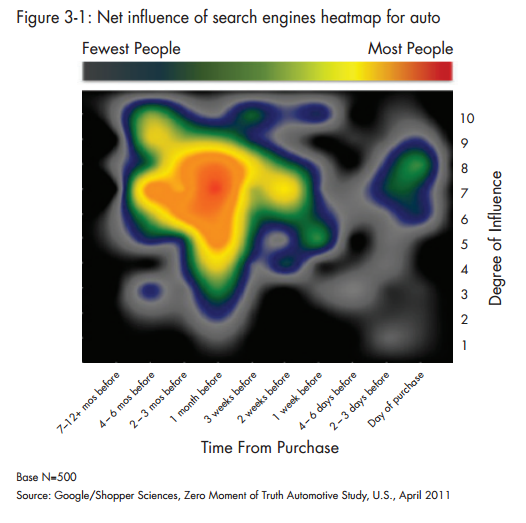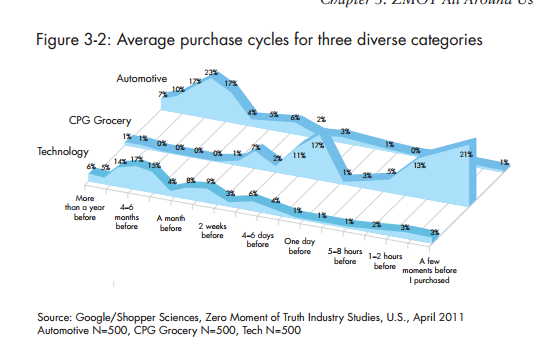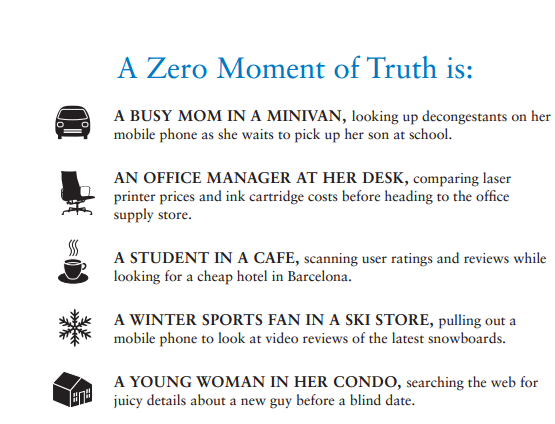Digital Marketing: Google’s “Zero Moment of Truth”
For last Tuesday’s SherpaBlog post, I covered some of our own MarketingSherpa research. This post is about an e-book from Google – Winning the Zero Moment of Truth – by Jim Lecinski, Managing Director of US Sales & Service and Chief ZMOT Evangelist, Google.
What is the Zero Moment of Truth?
Google defines the zero moment of truth, or ZMOT, as the decision-making moment of online shoppers.
Here’s how the process that leads to ZMOT is described on the e-book’s landing page:
Today we’re all digital explorers, seeking out online ratings, social media-based peer reviews, videos, and in-depth product details as we move down the path to purchase. Marketing has evolved and modern marketing strategies have to evolve with the changing shape of shopping.
Jim describes this process as something that “changed the rulebook” on “where marketing happens, where information happens, and where consumers make choices that affect the success and failure of nearly every brand in the world.”
That is a pretty bold statement, but as practicing marketers, you probably have to agree that digital marketing and the power that consumers (for B2C marketers) and clients (for B2B marketers) have in terms of finding the information they want, and not necessarily what you want them to see, has been a true game-changer.
Here are the elements of ZMOT:
- Not surprisingly for an e-book published by Google, Lecinski says that ZMOT happens online, usually started by a Web search via Bing, Google, Yahoo!, YouTube or another search engine
- It happens in real time – any time of the day or night
- The consumer is in charge and pulling information, not consuming a pushed message
- It’s satisfying an emotional need of the consumer
- The conversation involves many parties: the customer, marketers, friends, strangers, websites and experts
A few data points
I think it’s worth the time to check out the entire e-book, but I did want to share several data points from the document to give you an idea of what you can find.
- Google’s Shopper Sciences 2011 Macro Study found that 84% of decision makers used online sources to guide them
- 54% of those who used online sources reported comparison shopping for products online
- 70% of Americans look at product reviews before making a purchase
- 79% of consumers reported using a smartphone to help with shopping
- 83% of mothers reported conducting online research after seeing an interesting television ad
This chart shows just how long customers research a big ticket item, like a car purchase, and how that activity also picks up right before the purchase decision:
This is what Jim had to say about the chart:
What do car shoppers learn through search engines? It turns out that 64% say they look for price, 44% say vehicle performance and 37% say styling. Many were asking those questions four months before they bought their car.
And I thought this chart was interesting as well because it shows the difference in research timing and the decision-making process between an auto purchase, groceries and technology:
And here is Jim on this data – “The ‘dwell time’ that consumers spend during ZMOT is much longer than the time they’ll spend at a store shelf.”
ZMOT covers a lot of people and situations
This one final graphic helps to illustrate the various zero moments of truth:
Related Resources:
Winning the Zero Moment of Truth
Search Marketing: How to avoid and remove Google penalties
Long-tail Search Marketing: SEO how-to content and videos earn 9% conversion rate
7 signs that you’re overvaluing search engine optimization
PPC Ads: What is search engine marketing best used for?
How to Generate Leads Using Search and Social Media
Categories: Online Marketing













Very helpful post David. Thanks for sharing some important items on that ebook about “ZMOT”. According to the chart, a huge percentage of shoppers always look for the price first before getting that purchase. Makes sense.